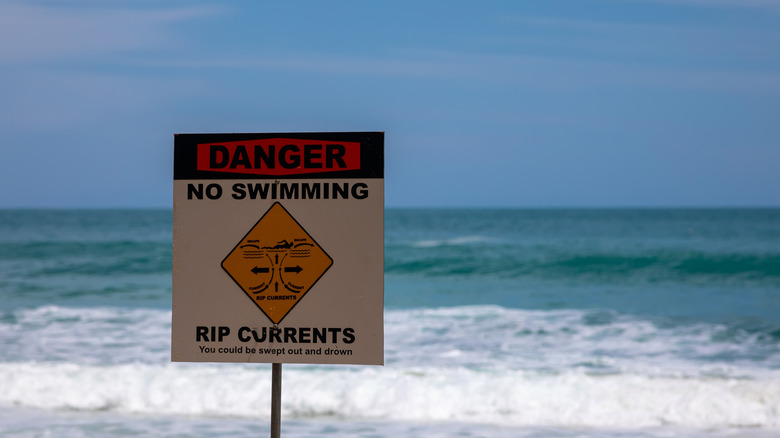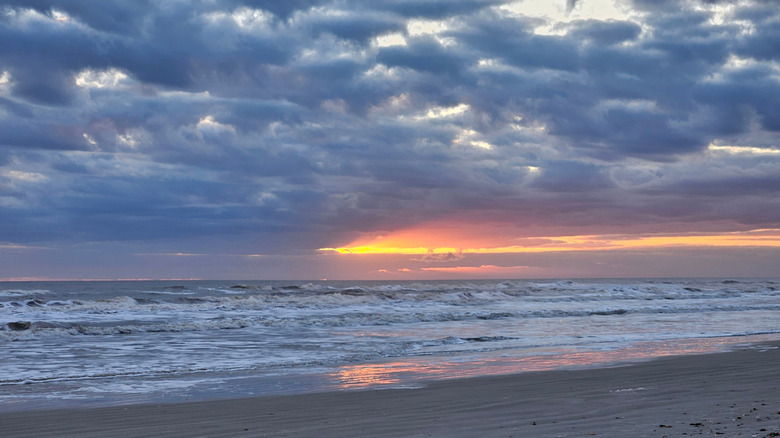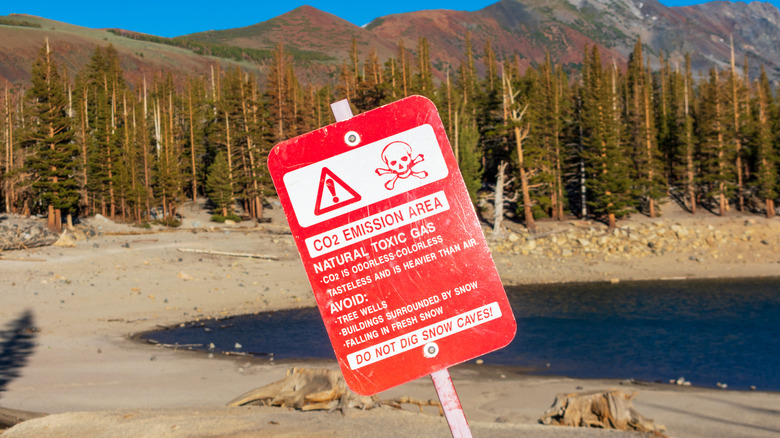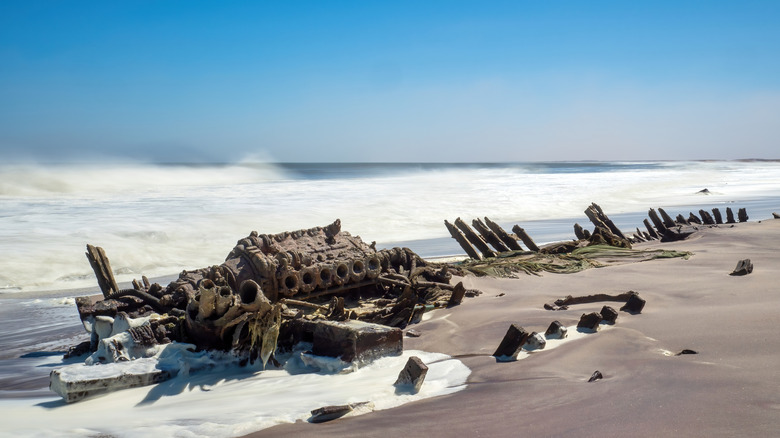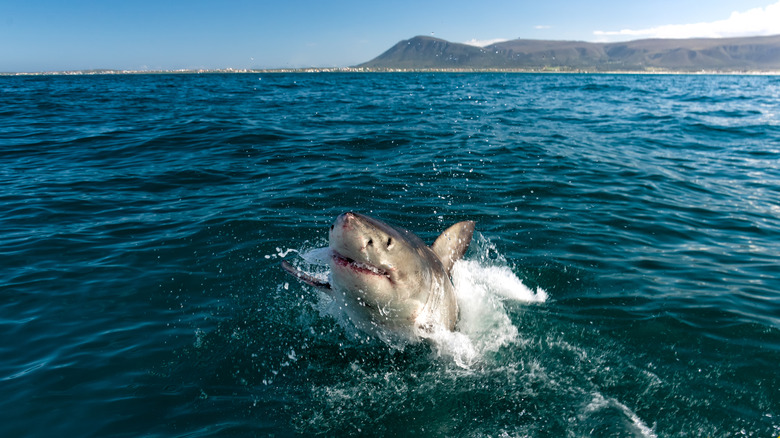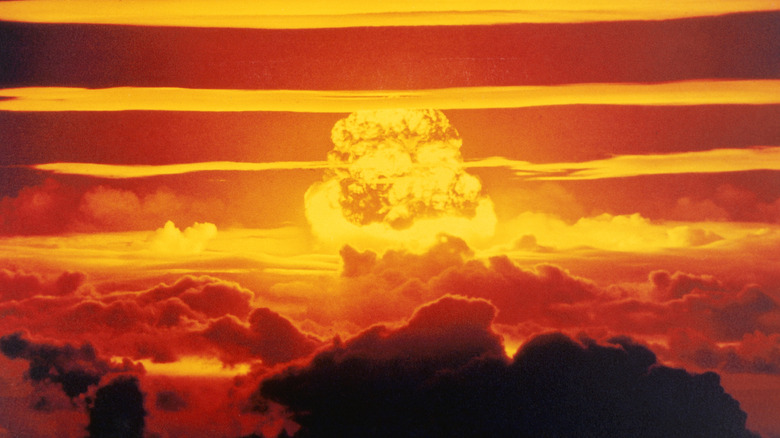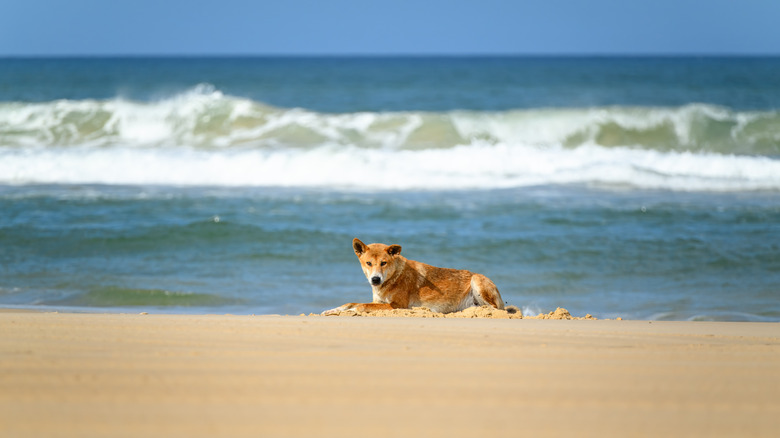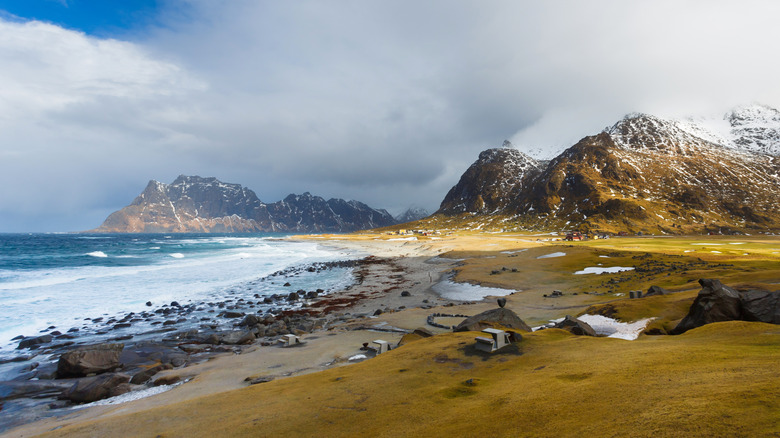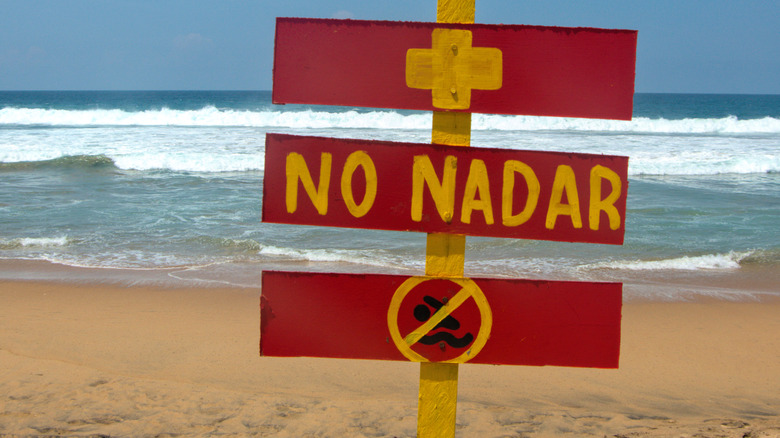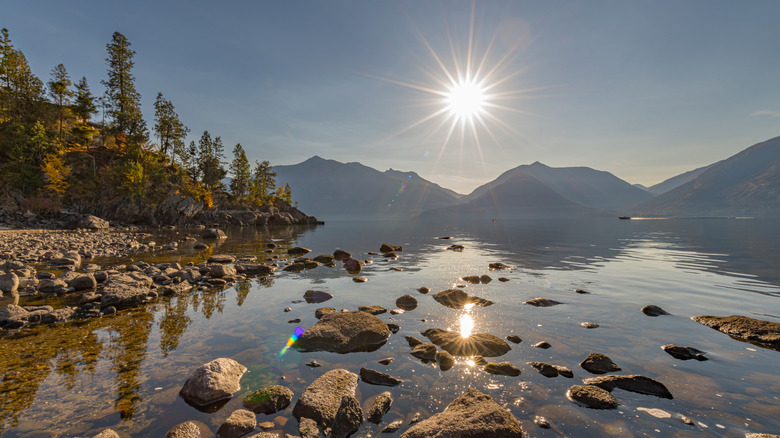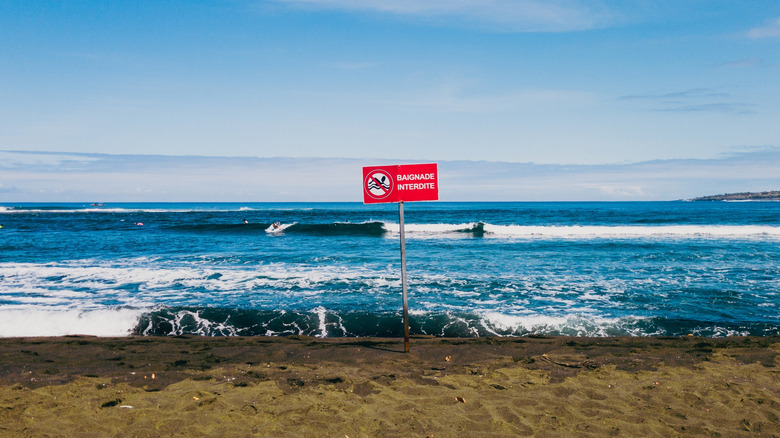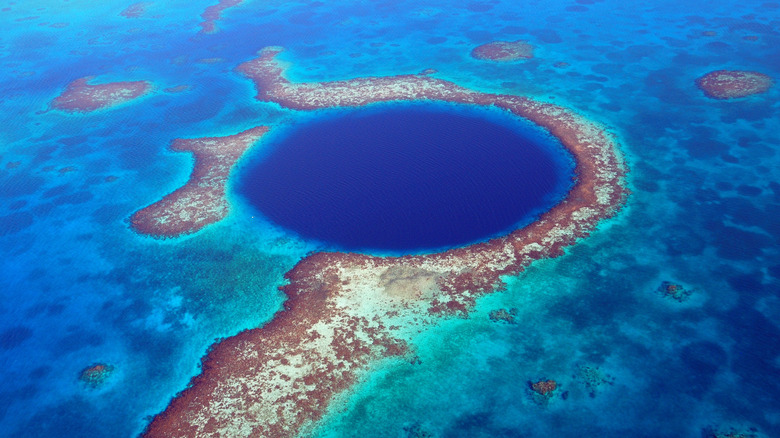The Most Dangerous Spots To Swim In The Whole World
If you love to swim and have ever wondered why some of your friends and family are terrified to dip their toes in the water, it's not just because they watched "Jaws" last summer. Well... maybe a little bit. In all seriousness, there are plenty of people who don't like to swim in open water conditions. According to Psychology Today, around 66 percent of Americans are afraid of deep open water. To be fair, their apprehensions seem reasonable.
The world may be filled with beautiful places to dive into, but it is also chock full of unbelievably dangerous places to swim. Suddenly, the fear of one of nature's deadliest ocean creatures grabbing you from the darkness below seems plausible — particularly at some of the very locations on this list.
While sharks and other dangerous sea life are certainly big concerns, each of the following locations showcases a different kind of swimming danger. Whether it's rip tides, poisonous plants, or atomic radiation, these 12 locations are, without doubt, the most dangerous spots to swim in the entire world. Let's dive in, shall we? (Pun intended.)
Florida's 'Shark Bite Capital' New Smyrna Beach
Despite its natural beauty and undeniable popularity, New Smyrna Beach in Florida holds the title of the "Shark Bite Capital of the World." There are several spots on this list that boast high numbers of numerous different types of highly dangerous sharks. But this Florida beach takes the cake in terms of just how many people have been attacked by sharks off its shores.
According to American Surf Magazine, over 300 people have been attacked by sharks at New Smyrna Beach since record-keeping began in the 1880s. As of this writing, the most recent attack occurred in September 2024, when a surfer was bitten on his ankle after accidentally stepping on a shark while leaving the water — an ordeal he described to FOX 35 Orlando.
The high amount of sharks is actually a result of the nature of the beach itself. The warm, murky waters offer an abundance of baitfish, which makes for easy feeding. The splashing and noise caused by the high visitor density also attracts sharks. This is perhaps the chief reason so many people have been unlucky at this beach. Maybe they should have filmed "Jaws" here instead of Martha's Vineyard.
The invisible killer at Horseshoe Lake
It's not the marine life at Horseshoe Lake in California that causes danger... it's the lack of it. There is a hidden danger here, one totally invisible to the naked eye. It has destroyed virtually all of the surrounding trees and vegetation, and has resulted in water so toxic it has the potential to kill you. Though this sounds like the beginning of a Stephen King novel, the dangers of Horseshoe Lake are very real.
This unseen terror is an unusually high amount of carbon dioxide that permeates the lake and surrounding wilderness. The result of long ago volcanic activity, the amounts of carbon dioxide exuding through the soil have done their part in killing most of the lake's vegetation and fish life. This has led to a dangerous algae bloom that releases toxins strong enough to kill pet dogs who may want to go for a splash.
Thankfully, there is good news. Unless you're crawling around the lake on your stomach, the high CO2 levels shouldn't bother you too much because the density of the gas keeps it lower to the ground. However, the CO2 does linger over the surface of the lake, where the air is naturally thicker and more humid. Combined with the toxic algae, these conditions make Horseshoe Lake an environment that is quite inhospitable for swimming.
Hanakapiai Beach is full of hidden dangers
There could hardly be a more idyllic set of islands than those of Hawaii. A combination of beautiful, white sand beaches, a thriving tourism industry, tropical rainforests, and plenty of island culture, Hawaii is a place that many cannot actually believe is part of the United States. However, hidden within this stunning geography lies one of the deadliest beaches in the world.
Nestled in a secluded corner of Kauai Island, Hanakapiai Beach is postcard Hawaii. The surrounding cliffs are studded with palm trees. The majestic falls and perfect sand all creating one truly dazzling setting. However, don't let this landscape fool you. The waters of the beach are no laughing matter. Not only are they filled with Hawaii's most terrifying marine life to beware of, but the very nature of the surf is dangerous. There is a reason locals have seen fit to carve a wooden warning sign at the base of the trail leading to the beach.
Hanakapiai's rip currents, shore breaks, extremely high surf, and a slippery, and unsteady geography make it a very dangerous place to hike and swim. According to Honolulu Civil Beat, the beach has claimed almost 30 lives between the 1970s and early 2010s due to the severity of the waters. Though the scenery makes a thrilling end to a long hike, you don't want to be caught unawares anywhere close to these waters.
Namibia's Skeleton Coast is a sailor's nightmare
Another coastline that sounds like the location of a horror novel, the Skeleton Coast of Namibia has a fearsome reputation. A Southern African nation sandwiched between Angola and South Africa, Namibia is considered one of the most remote countries in the world. Its coast is no different, offering anyone who visits mile upon mile of uninterrupted beach and stunning waves. Jeremy Clarkson, Richard Hammond, and James May of "The Grand Tour" did a dune buggy special there in 2016, giving their massive audience a scale of just how remote the Namibian coast is.
The trio also presented, quite clearly, the dangers of the Skeleton Coast. Thanks to heavy fog, invisible sand bars, intense winds, and incredibly strong currents, the Skeleton Coast has claimed the lives of many ships throughout the ages. Several sailors have died as a result of shipwrecks along this coast, and there are many skeletal wrecks still sitting on the beaches, hence the name.
With this reputation, it is no wonder that usually only seals can be seen bobbing up and down its coastline. Most visitors view the coast from land or in the air, which is just as well. With currents that have brought an end to so many ships and sailors, you would not want to be caught out in those waters. It could cost you your life.
Great whites off the coast of Gansbaai
Continuing down the coast of Africa, we come to Gansbaai in South Africa. New Smyrna Beach in Florida may be known as the "Shark Bite Capital of the World," but when it comes to the sheer number of sharks roaming the coastline, nowhere in the world has more than Gansbaai. Known as the "Great White Shark Capital of the World", Gansbaai's iconic sharks are more than just dangerous, they are utilized by locals for commercial gain.
Thanks to its status as one of the best places to see great white sharks in the wild, shark viewing is incredibly popular along the coast of Gansbaai. This is because you are guaranteed to see a great white from the relative safety of a thick metal shark cage. Any thrill seeker will jump at that chance.
However, regular swimming is incredibly risky along Gansbaai. While the coast itself is quite beautiful and the waves are excellent for surfing, anyone who goes out into these waters is taking their lives into their own hands. According to CNN, there were 29 unprovoked shark attacks that occurred in South Africa between 2012 and 2021. While the specific numbers for Gansbaai aren't available, knowing just how many there are doesn't exactly make it a swim-friendly area.
Bikini Atoll is the world's most radioactive island
Out in the middle of the vast Pacific Ocean are a string of islands so small and skinny that they could hardly be considered dangerous — they barely show up on a map. These are the Marshall Islands, now an independent republic that was once under the umbrella of the United States. Not all of the waters surrounding the Marshall Islands are dangerous. However, one particular lagoon, known as Bikini Atoll, will be dangerous for centuries to come.
Bikini Atoll was the site of over 20 nuclear weapons tests in the 1940s and 50s. Known as U.S. Navy Operation Crossroads, this project was the American military's scientific detonation of atomic and hydrogen bombs that would contribute to the development of one of the largest arsenals in the world. Much of that radioactive isotopes, debris, and soil is said to have been contained or removed, but the full extent of the tests' impact is yet to be known.
However, the lasting radiation and nuclear fallout have made the beach itself highly radioactive, and the waters surrounding Bikini Atoll inhospitable to human life. According to the Smithsonian, marine life is beginning to heal and rebuild from these nuclear tests, but the fact remains that this small stretch of sand is one of the most dangerous beaches in the entire world.
Sharks, snakes, and dingoes on Fraser Island
Australia has to have one of the worst reputations when it comes to dangerous animals. Home to the most venomous snakes in the world and some of the most dangerous spiders to roam the planet, it can sometimes seem like every beach here is trying to kill you. When it comes to the waters and beaches of Fraser Island, that statement isn't a stretch.
Also known as K'gari Island, this small, mainly untouched island off the coast of Queensland in eastern Australia is alive with dangers that should not be ignored. For starters, the waters surrounding the island are teeming with biting sharks, and dangerous rip currents that could drown you or send you far out to sea. The island itself is no less dangerous, populated by wild dingoes, as well as venomous snakes and spiders. The instability of the island's cliffs also result in frequent rockfalls.
While camping is allowed on the island, it can only be done in areas that have been deemed safe by the local authorities. Anyone thinking of doing so, and especially swimming off the coast, needs to approach their visit with extreme caution.
Giant hogweed makes Uttakleiv Beach poisonous
The Lofoten Islands in Norway are among the most scenic in all of Europe. Filled with dramatic cliffs, glaciers, and craggy coastline, anyone could find a reason to enjoy being in this mesmerizing location. However, when it comes to actually enjoying the waters of these islands, there is one beach that should be avoided at all costs.
Uttakleiv Beach is known for its beauty, but also for its temperamental nature. The weather here is unpredictable. It can be calm and sunny one moment, only to be enveloped in a subarctic storm at the next. The waters are also blisteringly cold, which could easily lead to cold shock and hypothermia for anyone bathing without the proper protective gear.
Then there is the presence of the giant hogweed found along the shore. This seemingly harmless plant hides a toxic sap that, when it comes into contact with the skin, can cause severe reactions like burns, irritation, and potentially permanent scarring. As beautiful as this beach may be upon viewing, the plant life and freezing waters make it one of the most dangerous in all of Europe.
Playa Zipolite is known as Beach of the Dead
Along the southern coast of Mexico is a popular location for surfers in North America: Playa Zipolite. The waves that come up along the coast are consistently substantial enough to get the attention of anyone with a board and a love for riding the strong currents. However, swimmers and surfers alike will have to be careful, because the waters of Playa Zipolite are so notorious that they have garnered a local nickname.
Known to residents as "Beach of the Dead," the waters of Playa Zipolite have claimed their fair share of lives over the years. The very thing that makes it so appealing to surfers is also what makes the beach so dangerous. The strong currents, rip tides, and incredible waves make for thrilling surf. However, a small slip up could very easily drown you, or have you crashing up against the sharp rocks that make up a good chunk of this coastline.
Nevertheless, the beach remains incredibly popular with backpackers due to its scenic beauty, and surfers for those excellent waves. It's also a popular spot for naturists thanks to its status as Mexico's only public nude beach.
Kootenay Lake's Six Mile Beach is deceptively dangerous
The province of British Columbia can rival anywhere in terms of scenic beauty. The dramatic coastline, the enormous forests of pine, maple, and oak, and the many lakes and streams that dot the landscape make it one of the most beautiful places in North America. And yet, hidden within that beauty is a danger that has cost one too many lives.
The Vancouver Island Free Daily calls Kootenay Lake's Six Mile Beach a "dangerous oasis." Over the course of many years, this popular area of the lake has been a prime location for vacationing tourists and those looking to live the lake life. The hidden dangers, however, are enough to make even the strongest swimmer cautious. Strong currents, strange topography, cold waters, and a sand bar with a steep drop off make the waters at Six Mile Beach deceptively dangerous. That sand bar, in particular, has resulted in several drownings over the years, many of which were young children.
Another dangerous aspect to Six Mile's waters are the invasive parasites that have caused illnesses among the local residents, and devastated some of the native wildlife. Several municipal movements are in the works to increase awareness of these dangerous waters, and also to increase public knowledge and safety when it comes to enjoying them.
Réunion is a stop on the shark highway
Réunion Island is one of the last vestiges of France's once powerful colonial empire. Geographically part of Africa, the island sits in the middle of the Indian Ocean and is a close neighbor to Madagascar. Visiting this island can seem more like enjoying the French Riviera as opposed to a subtropical African island. Stunningly beautiful in its own right, the location of the island does, unfortunately, make for incredibly risky swimming.
You see, Réunion is set smack dab in the middle of what is known as the "shark highway." This migration channel between South Africa and Australia brings all different species of shark to the waters surrounding Réunion. Highly aggressive tiger and bull sharks are responsible for many yearly attacks, several of which have been fatal.
Another dangerous fact is that Réunion itself is home to a small, but active volcano named Piton de la Fournaise. During and after eruptions, lava can flow directly into the waters of the Indian Ocean, making them far too hazardous to swim in. Increased temperatures and the dangerous fumes resulting from such activity are highly toxic and should be avoided at all costs.
The Great Blue Hole in Belize
There are so many reasons to visit Belize. The warm tropical weather. The amazing sandy beaches. The relaxation of a pure island getaway. It's a truly stunning place, and one that, yet again, hides some dangers. However, this one is pretty obvious, as it is enormous in size and incredibly popular to visit. We're talking of course about The Great Blue Hole.
Discovered by pioneering French oceanographer Jacques Cousteau, the Great Blue Hole is a natural wonder. At over 400 feet deep, the hole is one of the deepest ocean sinkholes in the entire world. While it begs to be explored, it's undeniably dangerous. In fact, in 2018, Forbes dubbed it "the world's deadliest dive site." Dangerous ocean species, lack of visibility, and sheer depth can create dangerous situations for anyone exploring.
This is not an exhaustive list by any stretch of the imagination. There are many more places in the world that are dangerous to swim. While we encourage exploration, we want to make sure you are safe when doing so. There are plenty of other, far less hazardous places to swim, snorkel, or dive in the world. Check out those places instead.
